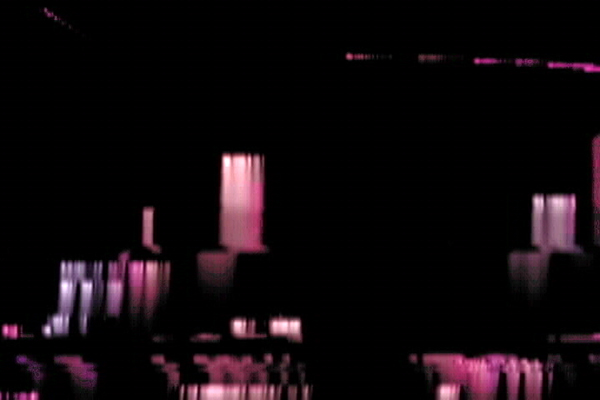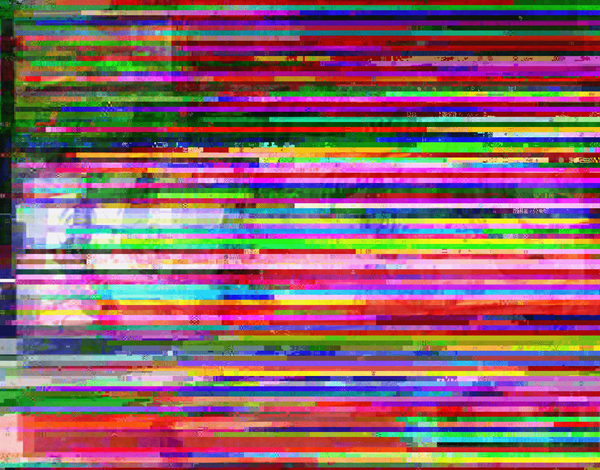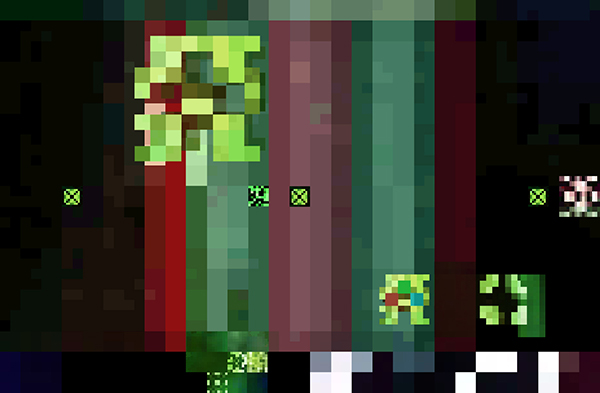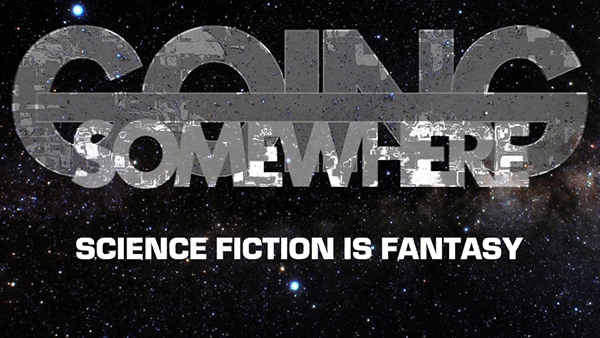|
This collection of historical notes, written between 2012 and 2017, about working with and on glitches has been floating in the either/or for a while. Since there's mot much history of any kind about glitches before the late '00s, I'm posting this personal narrative. I just realized I haven't done anything with it, so here it is. These are some general historical notes about my own experiences with glitches and their use in my work starting in the 1990s.

Still from Year (2003)
I am not sure when I first specifically called this kind of work �glitch,� but the concept and the work it produced have been continuous features of my work since 1989. I know I was using the term by 2001, and I did a bit of writing with it in 2003 for the Miami Art Exchange when it was the only publication engaged with Miami Art on a regular basis (this was before Art Basel Miami Beach). The deployment of accident (chance) within carefully prescribed frameworks enabled the uncontrolled, chaotic features of glitch art to develop organically from my technical and technological process focused on using the looping methods learnt from video feedback as the protocol for making all my work: iteration, revision, recursion.
My first works with glitches were in video, done in 1990, 1991 and 1992 with the digital freak-out that would happen when time code ran past the digital frame buffer of the NewTek Video Toaster on the Amiga 1000 systems available at Temple University. I used these failures in several videos; here's a sample from a piece called On Television the first of them, produced in 1990:
These were carefully saved on VHS tape and provided a reference point for my future movies. Feedback itself produced some of the more interesting results, as did the inconsistencies that arose between digitally processed video and its transfer onto 16mm film.
These pictures, made using the types of manipulation now familiar as "databending," became an on-going (if low key) area of interest following a catastrophic hard drive failure while working with Adobe Photoshop in 1993 that destroyed much of the data on my drive, and added "junk" to what image files I could recover. My experiments with these broken files elicited no positive responses from the few people I showed them to: puzzlement and the statement that my file was broken were the typical responses. I worked with these for several years, never really satisfied with the results. Sometimes the glitched file was the focus, other times, it provided source materials for more manipulation. The first round of broken pictures that "worked" emerged starting in 1995 and early 1996; posted on-line that year and then (almost immediately) removed: while the graphics were not broken, their glitched form resulted in visitors emailing me with slightly concerned brief messages to say my graphics were broken. That the page said that was how these pictures were supposed to look somehow missed the mark. This idea sat on my hard drive while I worked on other things.

The Gunz (1996)

Pattern 1 (1999)
"Broken pictures" and deranged video files (compression-based glitches) became increasingly common in the late 1990s during the final days of dial-up connections and long download times (I was poor and DSL was so expensive in those days). These fractured downloads, coupled with the problematics of cableTV in Miami, Florida (cable theft was rampant, and even if you paid, your neighbors would steal your signal, seriously degrading it) made video glitches a common part of my media landscape. This was the same period that glitch music started to make inroads in the electronic (and experimental) music scene in Miami, so it seemed like the idea was just �in the air.� I experimented with various ways to capture and manipulate these failings, using them as both subject-material and models for making my own work.
The kinds of video glitches and glitching I was working with in this time focused and revolved around the incorporation of feedback and technical failures, largely based in defective compression and the shuffling between formats, analog-digital media and rephotography all of which would then be polished down into something seamlessly, bright, colorful�yet originating with these technical failures. Malfunction (2000) is one of these productions, created by swapping the video codec for MPEG on my computer with a defective version, and transcoding the results into AVI:
These early engagements with digital files all emerged out of my engagement with the experimental and electronica music scenes in Miami that paralleled each other, but rarely ever actually intersected. Few of the film or video art people I knew had these interests in either digital technology, or its failures, but it was of active concern in both music scenes at the end of the 1990s. Much of this early DV work was made as experiments and trials that were only shown to a small circle of friends. When I would try to arrange shows of these videos I would usually either get rejected or a panicked email/phonec all about how my media was "broken." The idea of working with and showing im/pure failures just wasn't around at the time. The dynamic interplay between obviously glitched and less-obviously glitched was a 'feature' of my movie Year (2003). The "September 11" section makes these associations obvious. A still from this movie was included in the Glitch Art: Designing Imperfection book, published in 2009.
As Year shows, by 2003, glitched materials had become the dominant character of my source materials, even when the finished piece doesn�t look like it�s been glitched, and the formal connections between my own work and historical art struck me every time I started working on a new project. I developed several ways to work with glitch, not all of them immediately obvious as �glitch� in making my movies in the 1990s and early 2000s when DV was not yet HD:
(1) actual technical failures, captured and used �as such�;
(2) using the formal effects of technical failures as a model and making work with those features;
(3) using a technical failure as raw material, which is then processed and reworked, often with the result that it stops being recognizable as �failure�;
(4) using macroblocking and over compression to make the internal structure of DV become visible;
(5) digitally recording an analog glitch (as on an SD TV) but employing in camera processes to estrange it from its technical source.
I still use some of these processes, but my HD movies begin as high quality digital files that I then work to over compress, �degrade� through screen capture and databending, and manipulate as datastreams within the digital computer itself, rather than as a fusion of analog/digital. I began a general rethink of my engagement with glitches in 2009 as part of my shift into HD production. Some of the works from this transitional period are more clearly a product of databending than my earlier works. I had been avoiding that kind of glitch specifically because of the glitched background I created for Charles Recher's performance piece TV (2002). He was one of my friends who had seen what I was doing, even if it wasn't getting shown very much; he presented a few of my pieces in a curated program on South Florida at the Chinsegut conference in 2003. I avoided this clearly broekn work since I didn't want my work to be seen as derivative of my own (but uncredited) work! Miami was very much like that--if someone well known and established did something, even if you were already doing it or did it first, you would be seen as derivative. My installation piece Conjunction (2011) created for the Face2Face installation in Art Basel Miami Beach that year was my return to more clearly glitched work.
The series of works begun in 2010 that includes the movies Dancing Glitch(2013) and The Kodak Moment (2013) are engaged with an examination of the affect of digital glitches, specifically with their normative functions within a particular work both in the immediate encounter and over time across the duration of the movie itself.
The Kodak Moment in particular is important to my developemnt. It provides an opportunity to examine the relationship between those distortions effected by digital video encoding glitches and the perceived imagery presented on screen: what is under consideration in these two related experiments is the role that the recognizable figure has in the stabilization and normalization of these technical failures within the work itself. This concern is not simply a formal issue. The interpreted status of the depiction as glitched (as unintentional/autonomous technical failure) or as a coherent not-glitched visual form (i.e. interpretable as an intentional construction) has an impact on the avenues of interpretation available to considerations of the work since an identification as unintentional technical failure renders the formal dimensions of the work moot, thus their impact in shaping any interpretation is negligible�it is �noise� to ignore rather than �signal� to consider.
The glitch techniques I am using for the works starting with the music video Helios | Divine (2013) engage with the data stream to create a continuous flow of imagery that functions syntactically. In this project, I use glitches to eschew montage and the long take�so that each shot develops seamlessly into the next, morphing from one image into another. This continuous flow of imagery in blocked fragments is the fundamental �unit� of assembly throughout this series. By working with multiple �blocks� at different scales�some glitched, some not�allows me to explore the balance between indexical recognitions common to photography and found footage films, versus the graphic, geometric forms specific to digital graphics and imagery. This process depends on extracting a dataset from within a pre-existing work. It is analogous to the recognitions of earlier films common to found footage films, but how appropriated imagery functions in glitch videos evades established relationships of realism and quotation, making these movies post-digital. This use of digital compression and encoding forces a reconsideration of productive protocols and critical methodologies since the assumptions used by established frameworks are in question; it is not a rejection of earlier approaches, but the necessity for their re-interrogation that glitch can demonstrate. This relationship is easy to conceptualize, but it is challenging to actually employ in a movie; arriving at both a set of protocols and working process to achieve this result has taken several years� work�my production methods for the serial Going Somewhere originate with this experience. I did not want to focus on the problems of how to make my imagery, so I would be able to focus instead on its meaning and development in each 7-minute episode/module.

Glitching functions syntactically, creating the fusion of frames and linking shot-quotations while at the same time providing inflection that changes the imagery�s meaning separately from issues of montage or sequence. The continuous flow of imagery is precisely the point to this process: there is only a limited distinction between one �shot� and the next, eschewing montage for the continuity of the long take�data stream of the digital file. The results are neither edited nor animated, but a hybrid recognizable as the �morph� where one image becomes the next seamlessly by degrees of change over time. These technically-generated transformations give rise to both the abstracting and representing dimensions of the imagery equally.
|

|